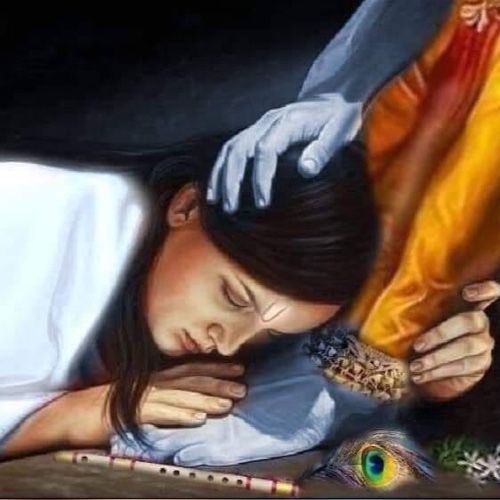Bhaj Govindam Verse 16
Bhaj Govindam
Today’s verse is written by Guru Hastamalaka. The fragrance of each guru’s experience is present in his/her discourses or writing. Guru Hastamalaka, a disciple of the Great Guru Shankaracharya, was born in a very pious village, to a devout family. He remained like a dumb-dim-wit and this worried his father, and when Shankaracharya came, his father took him to meet this sage, in order to find a cure. At that time Hastamalaka, when asked, Who are you? By Shankaracharya - sang out the essence of the very existence.
Hence, Guru Shankaracharyaji not only took him as his disciple, but also named him Hastamalaka, which means the one who has fruit amla (goose-berry) in his hand. It refers to the one who has the divine knowledge in his palm, he who was awakened and enlightened, and he who did not have to go through any Guru, knowledge, Shastras or tapas, he was born enlightened.
Yeh sukh sadan se nahin hoye,
Tumhari kripa paye koi koi.
To get realisation there is no set route, rule, path or Sadhana,
This happens with God’s grace alone, and this is bestowed upon only a few.
Being in the vicinity of great scholars, pandit, sadhus from his very childhood, he must have seen, what he expresses in this verse.
Verse 16
अग्रे वह्निः पृष्ठेभानुः,
रात्रौ चुबुकसमर्पितजानुः।
करतलभिक्षस्तरुतलवासः,
तदपि न मुञ्चत्याशापाशः॥
सूर्यास्त के बाद, रात्रि में आग जला कर और घुटनों में सर छिपाकर सर्दी बचाने वाला , हाथ में भिक्षा का अन्न खाने वाला, पेड़ के नीचे रहने वाला भी अपनी इच्छाओं के बंधन को छोड़ नहीं पाता है॥
Agre Vahnih Prsthe Bhanuh
Ratrau Cubukasamarpitajanuh
Karatalabhiksastarutalavasah
Tadapi Na Muncatyasapasah
The sixteenth verse said to me - Shruti Says🌷
When the sun goes away, at night he lights the fire and sits coiled up to shield himself from the cold.
Having no vessels he eats whatever his hand can hold, takes bhiksha only in his hand.
The one who has no home, wander and stays under the tree.
Even this kind of a sanyasi is unable to leave his desires and expectation.
———————————————
He is describing here a sanyasi - sanyasis are not allowed to do any kind of ‘Sangrah’ or accumulation. The minute one enters the sanyas ashram, there is a decorum that one has to follow. As mentioned many times before, there is a decorum for each ashram, no ashram is inferior to the other, they just have their own rules. What we see today in the name of Sanyas, is not what the ashram demands. It is unfortunate that the gullible public, just seeing coloured robes get deluded and falls at their feet (Never before in the history of Sanatan Dharma, the Grihast Ashram has had such a low self esteem of the self). The true sanyasis are hidden, and the ones we are reaching for, are not even close to being called one.
What Hastamalaka ji says here is that even such a sanyasi, who has been able to follow the decorum of the ashram, has been able to align the deeds and words to being a true sanyasi, he/she also can fail at aligning the thoughts, and in the thoughts rages the fire of desire and expectation. One can forcefully control ones body and the tongue, but the mind can not be controlled by force.
Then what does one do, to get rid of this Ashapasha - the shackles of Desire and Expectation?
Well, we have all heard about the domino affect, one domino pushed and automatically all the other dominos which are ahead start falling, the domino in the front does not make the effort to fall either, it is effortlessly pushed. Even the first domino does not make the effort to fall, it is pushed.
If we follow the decorum of each ashram as mentioned in the scriptures, one ashram helps us glide to another and by the time we reach sanyas ashram the mind will be filled with only sublime thoughts. It is worth to note here, that just like with the dawn of old age, desires don’t vanish, in the same ways external changes and deprivations do not lead to alienation of desire and exceptions.
A few question we need to ask ourself if we are on the path - As such we are all on the path, the difference is some know and the others don’t know.
Kese hua? Pata nahin hogeya aur hota chalageya?
How did this happen? I don’t know it happened and then it went on happening?
But, if someone says,
Kese hua? Maine japa kiya tapa kiya yog kiya kriya upwas kiya…. and so on
How did this happen? I did japa, tapa, kriya, yoga, fasting … and so on
Who amongst the two is a Sadhak or paths is going to reap result? Let’s try to understand further, by referring to the following 3 opposites.
- Sublimation vs Suppression
- Sadhan vs Sadhana
- Hate vs Love
Sublimation vs Suppression
“Taba lago hrdaya basata khala nana,
lobha mola macchara mada mana,
jaba lago ura na basata raghunatha,
dhare capa sayaka kati bhatha.”
“That villainous crew -greed, infatuation, jealousy, arrogance and pride - haunts the mind only so long as the lord of the Raghus does not take up his abode there, armed with a bow and arrow and with a quiver fastened at his waist.”
Turning the mind towards the Higher, when both the hand are turned towards God, the negative tendencies are automatically dropped.
Suppression - fighting the negative head on
Sublimation - focusing on something divine and letting the vice thin automatically
"Suppression of urge is not eradication. You can never be free of that which is suppressed. The suppressed desire will attack you again and again and will produce irritability and restlessness of mind. It will again manifest with redoubled force when a suitable opportunity arises and when the will becomes weak.
The mind should be rendered pure by meditation, Japa, Kirtan and prayer. If the mind is filled with sublime divine thoughts by meditation, Japa, prayer and study of holy scriptures, the desire will be devitalised or de-energised by the withdrawal of the mind. The mind also will be thinned." (Swami Shivandaji)
“Sublimations literally means from solid to vapour. So, it leads you away from your attachments and selfishness, and you transform yourself into a pure state of selflessness and divine love.”
Sadhana vs Sadhan
- Is maun the outcome of peace or peace the outcome of maun?
- Is ahimsa the outcome of love or love the outcome of ahimsa?
- Are the Shastras the outcome of Self-knowledge or Self-knowledge the outcome of Shastras?
- Are Vedas the outcome of Self-realisation or self-realisation the outcome of the study of Vedas?
Many a times we Ape the Saints, not understanding, that what he is doing is the end and not the Means to the end. For instance, we see a saint in the jungle, and conclude that we need to be in the jungle (Vanvas) to become blissful and emit bliss. Little knowing that going to the jungle alone will not get us bliss.
Why observe maun?
When I am in maun and my objective is to attain peace of mind, calm myself down or any other objective - I am still in the taking state and I want to take from outside. This state is seeking, is a means not the end.
When I am already in peace and still observe maun, because I want to remain silent and not utter unnecessary words, which might hurt someones feeling even by mistake - I am in a giving state, this state is not seeking any result. It is the end in itself.
In the same way we can analyse anything for instance, Fasting.
Why do we fast?
When, I am fasting (eating constrains) to cleanse myself, control my sense - I am still in the taking state.
When, I am fasting, cause I don’t want to eat for pleasure or over eat. Out of compassion for the people who don’t have much or the food itself - I am in a giving state, this again is an end in itself.
So, The taking state is Sadhan and the giving state is Sadhana.
When Sadhan becomes Sadhana - It has the ability to join the Sadhak(devotee) to the Sadhye(Lord) with the string of Love.
One guru said - Sadhan ghada (donkey) hai
Person asked - Then why should I do Sadhan?
Guru - To experience that Sadhan is Ghada - Sadhan to karna hi padega na.
It means that as the end of it all, Sadhan is not needed, but only the one who does sadhan can reach that realisation, so it has to be done, even thought it is useless.
Universal Love vs Hate
What is the reason for one to move towards isolation is also very important.
- Is it escapism
- Is it hurt
- Is it disgust towards the world and it’s way
If one is willing to leave the world for such reasons, the foundation itself is flawed and the result can never lead to Self/God realisation.
However, when one starts to see the divine in all living and non-living things, and universal love arises in the blossoms of this individual, there is sway in his walk and this infectious affection in his talk. This one has even while being in the midst of samsar become a renunciate.
Kis se bandhu ber jagat mai,
Koi nahin paraya.
Haar manav mai pratibim lekar usi,
Brahm ki chaya.
Whom should I despise in this world,
there is nobody who is not mine.
In every individual,
I can see God.
Hastamalakaji, who himself was enlightened by birth, is telling us that it is not external austerity, but internal tranquility that is needed. Austerity follows tranquility and tranquility follows God. It is not suppression, but sublimation. It is not Sadhan but Sadhana and it is not Hate but universal love that will help align maan/thought and make one a true sanyasi. All will drop, one by one as the God takes over, the point where there is effortless effort to no effort - bus hota chalageya. The one who fails to understand this, even after having given up the material world, is still entangled in it.
Hari Om


